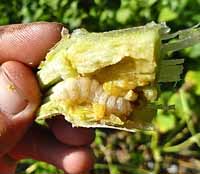To place the certified organic seal on their produce, farmers must follow a strict list of rules. Home gardeners who want to use organic practices can take the first steps by using methods one University of Georgia expert calls “modified organics.”
“Since 9/11, there has been a food safety scare, and I have seen an increase in the number of people growing their own vegetables,” said Bob Westerfield, a UGA Extension consumer horticulturist based on the Griffin campus. “People know what they grow is safer than what they buy from say, Mexico — where you don’t know what has been applied to it.”
Westerfield shares the following “modified organic” tips he uses on his Pike County farm.
Good soil
Start with good soil. Garden soil should contain about five percent organic matter. Westerfield added 17 tons of “dark, earthy, organic sand” to his soil. Buy soil in bulk to save money.
Know your soil’s needs. Take a soil sample to the local UGA Extension office for a soil test. Unfortunately, the results do not provide organic conversions.
“You may have to mix and match organic products like bone meal and horse manure or go to a farm supply store that sells organic mixtures, he said.
UGA Extension provides a conversion table for inorganic to organic soil amendments at caes.uga.edu/publications
Westerfield said gardeners should expect to pay more for some of these amendments, so check around for pricing and build the cost into your garden budget.
Know your manure. Traditionally, farmers amend soil by adding animal manure. Most manure contain pesticides from the forage animals are fed. This makes the manures off limits to organic growers.
No treated lumber. Organic gardeners can’t use treated lumber to built raised beds. Build a berm using cinder blocks or non-treated wood instead.
Nitrogen from nature
Plant cover crops. They add nutrients to garden soil. Plant a cereal grain mixed with a legume in your garden in the fall. In the spring, mow and till the cover crop into the soil.
Buckwheat, millet, sorghum, wheat, oats and rye can be planted as summer cover crops. Do not use ryegrass as “it secretes substances out of its roots that prevent other crops from growing,” Westerfield said.
Water correctly. Use drip irrigation because overhead watering is inefficient. “The less you wet the foliage, the better you are going to be,” he said. “Watering tomato leaves particularly encourages disease.”
Smother weeds. Control weeds using garden mats with precut holes for inserting seeds or transplants. The mats smother the weeds underneath. Westerfield uses newspapers covered with straw around plants, and, he “weeds” between rows with a tiller.
Use the sun to fight weeds. Till the area, moisten it and then cover it with layers of plastic secured in place with rocks. Let it sit for four weeks to allow the sun to bake the area underneath to temperatures of 140, 150 or 160 degrees.
The right plants
Buy resistant varieties. To control diseases and pests without pesticides, plant resistant varieties. Avoid heirloom varieties. Westerfield still plants heirloom varieties, he just plants more. “The animals get a few, the diseases get a few and there’s still enough for me,” he said.
Leave some space. Plants need ventilation to keep diseases at bay. “When you jam plants together, you create a clammy atmosphere that diseases love,” he said.
Stagger planting times. This is an organic way to fight pests like squash vine borers. “I plant a new crop of squash every couple of weeks to stay ahead of them. I’ve tried organic sprays and have not had success. I wouldn’t be surprised if we see (resistant) squash varieties soon,” Westerfield said.
Harvest vegetables young. This provides three benefits; the produce is more flavorful, the plant produces more and there are less pests. “As fruit matures, it puts off an odor. When predator bugs smell overripe fruit, they come running,” he said.
Rotate crops. This old time technique is still an effective way to reduce disease pressure. “Basically, don’t put the same family of crops in the same spot year after year,” Westerfield said. Record what you plant and where, each season in a gardening notebook.
For more information on backyard gardening in Georgia, see the UGA Extension publication at www.caes.uga.edu/publications/.







